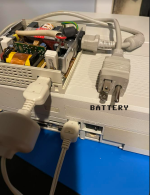TheLastNinja
Member
- Joined
- Apr 27, 2023
- Messages
- 25
Good evening,
I have an issue with a PSU's and I feel I have gone as far as I can without direction or help from someone more experienced.
I'm learning as I go (with electronics) since starting collecting vintage machines, I began with a C64 with a black screen, have done some moding here and there and enjoy making PCB projects for them etc so I have acquired some knowledge but I'm still learning as I come across issues.
I'll try and give important details that may assist in a resolution.
The machine has a detachable PSU block that can be swapped with a battery.
To charge the battery, you remove the PSU from the machine and plug into the wall and connect a small AC cable from PSU to Battery.
The PSU takes AC100-240V and outputs DC20V 2A
When I tested the PSU, the output was only DC .06
The computer appears fine. I have a voltage generator and set it to 20V DC 2A, plugged it into the battery AC cable instead of the PSU and it charged the battery, and the computer turned on.
There appeared to be capacitor residue, no damage to anything but I changed those (330uf 35v 2x 390uf 35v) but they didn't solve the issue unfortunately.
I ordered a replacement NEC AC08F as a guess.
Nothing looks damaged or any signs other than the residue. The owner said it worked the last time they checked not long ago for what that's worth.
Any ideas why it's outputting a tiny DC voltage? fixable?
*** not an important question but if someone has this machine, on boot it says something about CMOS parameter's missing and time before the DOS prompt. When I opened the computer looking for clues on the PSU issue I noticed there was an empty slot for a square chip. Is that just for expansion or should there be a chip there?
Thank you
I have an issue with a PSU's and I feel I have gone as far as I can without direction or help from someone more experienced.
I'm learning as I go (with electronics) since starting collecting vintage machines, I began with a C64 with a black screen, have done some moding here and there and enjoy making PCB projects for them etc so I have acquired some knowledge but I'm still learning as I come across issues.
I'll try and give important details that may assist in a resolution.
The machine has a detachable PSU block that can be swapped with a battery.
To charge the battery, you remove the PSU from the machine and plug into the wall and connect a small AC cable from PSU to Battery.
The PSU takes AC100-240V and outputs DC20V 2A
When I tested the PSU, the output was only DC .06
The computer appears fine. I have a voltage generator and set it to 20V DC 2A, plugged it into the battery AC cable instead of the PSU and it charged the battery, and the computer turned on.
There appeared to be capacitor residue, no damage to anything but I changed those (330uf 35v 2x 390uf 35v) but they didn't solve the issue unfortunately.
I ordered a replacement NEC AC08F as a guess.
Nothing looks damaged or any signs other than the residue. The owner said it worked the last time they checked not long ago for what that's worth.
Any ideas why it's outputting a tiny DC voltage? fixable?
*** not an important question but if someone has this machine, on boot it says something about CMOS parameter's missing and time before the DOS prompt. When I opened the computer looking for clues on the PSU issue I noticed there was an empty slot for a square chip. Is that just for expansion or should there be a chip there?
Thank you










